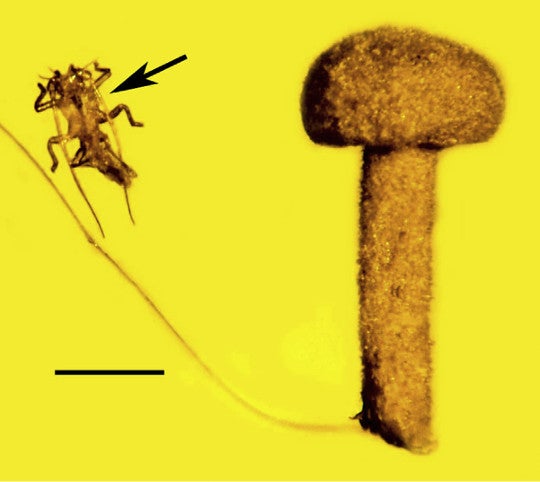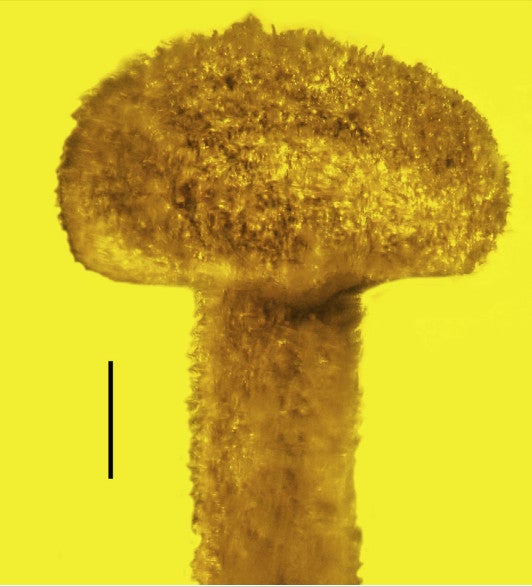This article was published in Scientific American’s former blog network and reflects the views of the author, not necessarily those of Scientific American

Still life with shed juvenile insect exoskeleton, mammal hair, and mushroom. Scale bar = 0.5 mm. Credit: Poinar Jr. 2016
Dateline: Northern Europe, 50 million years ago. A subtropical conifer forest similar to the southeastern United States (or what it looked like 200 years ago, anyway).
A phasmid nymph, the juvenile of a creature related to a walking stick, prospects a mushroom. It notices, perhaps because it is already caught up in the horrible, sticky – yet delightfully pine fresh! -- flow, that it is about to be entombed in amber. Though this might mean a shot a future scientific glory and possibly even the coveted cover of Fungal Biology, after carefully weighing its options the insect opts for short-term gain. It does something we vertebrates can only envy from afar and jumps out of its own skin.
On supporting science journalism
If you're enjoying this article, consider supporting our award-winning journalism by subscribing. By purchasing a subscription you are helping to ensure the future of impactful stories about the discoveries and ideas shaping our world today.
We can infer something like this must have happened because the mushroom, the skin, and a mammal hair were found all together in a single piece of amber described recently in Fungal Biology by George Poinar Jr. of Oregon State University. The mammal hair is suggestive of something else that might have happened just prior to entombment, because the mushroom stump also appears to have rodent bite marks, Poinar suggests.
The narrow escape suggested above is a strong possibility, but not the only one. It is also possible the insect cast off its skin prior to the skin’s engulfment by tree resin, but if that was the case, it had to have happened very, very shortly before. How do we know? Because the inside of the insect skin contains filaments that would have vanished if it had been shed for very long. In modern phasmids, a juvenile will shed its skin several times in just a few months before maturing, each time providing an opportunity to hit the emergency eject button.
The mushroom itself is enigmatic, because we lack spores or the stem’s base, both keys to identifying modern mushrooms. It is also tiny. From top to broken bottom it measures just 1.8 millimeters, and it is covered with small scales.

The scaly cap and stalk of Gerontomyces lepidotus in Baltic amber. Scale Bar = 0.2 mm. Credit: Poinar Jr. 2016
Aside from knowing it’s a new species, Poinar wrote, it’s not possible to say much more about this mushroom. One wonders if a DNA test might help. That would, of course, involve drilling into and marring the specimen permanently.
This mushroom from the Baltic amber is the very first. That is somewhat puzzling, because the Baltic amber deposit is the largest in the world. It formed when a tropical and subtropical rainforests covered most of northern Europe about 45-55 million years ago.
Mushrooms frozen in amber have been found before from other amber deposits as old as the Cretaceous, during the final act of the dinosaurs. In fact, amber is where most fossil mushrooms come from, since as anyone with lawn mushrooms knows, their time on this Earth is abbreviated. Amber, almost alone, has the power to rescue them from their rapidly encroaching fate as a pile of goo and render them gloriously immortal.
Reference
Poinar, George. "A gilled mushroom, Gerontomyces lepidotus gen. et sp. nov.(Basidiomycota: Agaricales), in Baltic amber." Fungal Biology (2016).